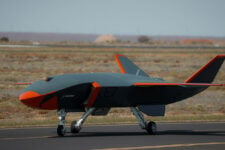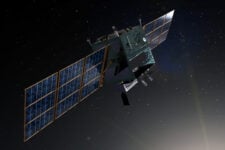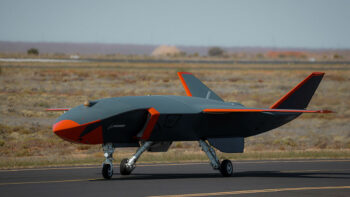
Frank Calvelli, Assistant Secretary of the Air Force for Space Acquisition and Integration, speaks at the 2022 Air, Space & Cyber Conference. (Credit: AFA)
GEOINT 2024 — The Department of the Air Force has delayed certifying a design baseline for the
Space Force’s program with the National Reconnaissance Office (NRO) to develop a new satellite system to track moving targets on the ground — with space acquisition czar Frank Calvelli punting the review to allow time to flesh out the program’s likely costs, according to a spokesperson for his office.
The delay in the review, however, is not expected to impact the planned delivery schedule, the spokesperson said. That said, neither the Space Force nor the NRO has revealed their hoped-for schedule.
While the NRO is partnering on the Ground Moving Target Indicator (GMTI) satellites, the Air Force, which holds acquisition reins for the Space Force, has the power to manage the program’s progress through the acquisition process. Calvelli in February said GMTI would undergo its Milestone B review at the end of March, but that has now been pushed back a few months.
“As the Milestone Decision Authority for the GMTI program, Mr. Calvelli has directed the program’s Milestone B decision be moved to later this summer. This short delay to the Milestone B decision allows collection of additional data to improve the fidelity of the program’s cost estimate and has no impact on the program schedule,” the spokesperson said. “Getting the cost estimate right is critical for establishing an executable programmatic baseline at Milestone B.”
Milestone B is the decision point in the acquisition cycle “designed to ensure program risks have been adequately mitigated to support a commitment to system design, development, and production. It formally sets the acquisition program baseline, which is the fundamental agreement between the Program Manager and the acquisition Decision Authority on program cost, schedule, and performance parameters,” the spokesperson explained.
The GMTI satellites are being designed to help plug a gap in gathering intelligence, surveillance and reconnaissance (ISR) imagery used to target terrestrial threats left by the Air Force’s divestment of the E-8C Joint Surveillance Target Attack Radar System (JSTARS), an aging aircraft the service reasoned is not survivable against updated Chinese and Russian anti-access/area denial arsenals.
The GMTI development program has faced some policy hurdles, not the least of which have been arguments between the partners over the acquisition strategy.
More recently, the plan for operations of the satellites has been the subject of a roles and missions tug-of-war between the Space Force and the National Geospatial-Intelligence Agency (NGA). The service has been arguing that it needs to be in control of GMTI satellite operations so that military commanders can directly task the GMTI birds to areas of immediate threat — and the satellites enabled to directly downlink, via Space Force networks, targeting data to “shooter” platforms such as bomber aircraft. NGA, however, has begged to differ, citing its mission as a combat support agency and its remit to ensure that ISR data is accurate.
And while Space Force leaders have been adamant in asserting that GMTI satellites, like JSTARS, are a tactical asset falling under Title 10 military responsibilities, there are two non-trivial hurdles to the service assuming tasking authority in the near future.
First, the service does not have a command and control (C2) system capable of allowing direct tasking of those birds. The Space Force does have experience in tasking, via operating its fleet of Space Based Infrared System (SBIRS) missile warning satellites. But that is a bespoke capability — the service has had to work on developing a different C2 system even for its planned SBIRS replacement, the Next Generation Overhead Persistent Infrared (Next-Gen OPIR) satellites, and that system already is suffering schedule overruns.
Nor does the Space Force have a functioning communications network that can directly link, machine-to-machine, satellites to shooters to transfer targeting data gathered — although that is something the Space Development Agency is working toward with its planned Transport Layer data relay satellites. The agency currently has 19 test versions on orbit, with the first operational variants capable of limited regional use scheduled to be functional by the end of 2025.
“We don’t even have this network built yet of these [GMTI] sensors, so I can’t tell you that there’s a system that distributes data,” Lt. Gen. David Miller, head of Space Operations Command, told reporters here on Monday in response to a question from Breaking Defense.
“This is in the process of being developed and fielded. The network, the global network, that will allow for a level of, frankly, unprecedented resilience for dissemination, but also on the front end of that the collection and processing to be coordinated and automatically processed and then sent down to the dissemination node, that is all part of the future architecture that our team at the Space Warfighting Analysis Center is building out right now,” he said.
“I’ve received two briefings on so far,” Miller added. “We’re in the middle of resourcing that network. It is being timed to be realized in stages as these capabilities develop. And, at least from what I’ve seen from our SWAC teammates, I’m very comfortable that they’ve got a good plan.”






















